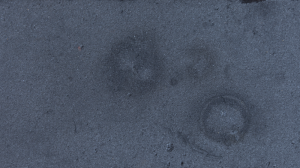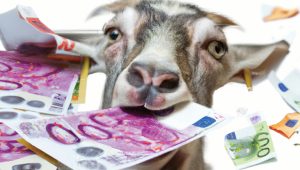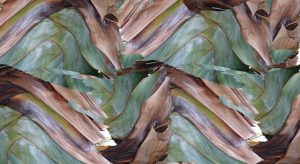Veronica Burnuthian, Aelita le Quément, Santiago Archila Salcedo, and others are exhibiting at the Kunstarkaden with their exhibition “Frémito,” featuring a hypnotic and colorful mix of works that explore dreams, spirituality, and the subconscious.
For the Long Night of Museums on October 18, 2025, the artists invite visitors to a special program:
At 8, 9, and 10 p.m., there will be a midnight screening of specially produced horror and science fiction short films. These cinematic works enter into a thrilling dialogue with live music, which reinterprets the works and intensifies their atmosphere. The combination of image and sound creates an immersive experience that transports the themes of the exhibition to another sensory level.
In the Dadaist cosmos of ‘Kyoto Morph and the Four Feet of Benjamin’, poetic and absurd visual worlds unfold between dream and reality. Babi Brüller, Luisa Baldhuber, Florian Donnerstag and Nina Markhardt interweave painting, installation, sculpture and expanded pictorial spaces to create a symphonic landscape of colour. Between Far Eastern tranquillity and urban surrealism, whimsical scenarios emerge that draw the eye and arouse curiosity without giving too much away. A kaleidoscopic togetherness that invites you to linger with humour and poetry.
In her work, Babi Brüller explores her family’s Jewish heritage as well as social structures and the power of authoritarian collectives. Movable, mostly life-size dolls in slightly grotesque depictions occupy the exhibition space. Large-format paintings show groups of similar, androgynous individuals (e.g. choir singers, schoolchildren, soldiers) in surreal spaces in which the uncanny dynamics of these groupings are inherent.
In her artistic work, Luisa Baldhuber deals with the interplay of color, space and light and their influence on our perception. Based on classical painting, she transfers color surfaces into space, breaks through architectural structures and opens up new dimensions between fiction and reality.
Florian Donnerstag’s work deals with the ambivalence between form and design. Breaks, asymmetries and the deliberate questioning of content serve as artistic tools in his paintings. In his practice, content becomes a formal element that unfolds beyond unambiguous symbolism and develops an anti-symbolic effect. In this way, he creates works that defy any unambiguous legibility and open up new narrative levels.
Nina Markhardt explores the role of fungi and algae on different levels of time and works with biodegradable materials. Her bioplastic sculptures and paintings stand for a sustainable artistic approach and address the interconnectedness of all living beings.
Flyer_Kyoto Morph und die vier Füße von Bejamin
Start your evening in the municipal art spaces.
Come by for insights, exchange or just for fun.
Free admission, art, punch & snacks
5-7 pm
The municipal art spaces around Marienplatz invite you to get to know a new exhibition every month in either the Artothek & Bildersaal, the Kunstarkaden, the MaximiliansForum or the Rathausgalerie.
This time, the Kunstarkaden are delighted to invite you to the exhibition “Der Preis”. You can start your evening with punch, snacks and art and meet nice people. Come alone or with friends, for insights, exchange or just for fun. We look forward to seeing you!
The event is free of charge.
‘Der Preis’ is an exhibition that makes the art market tangible as a game of chance. Four artists jointly invest a starting capital from their own pockets, each work sold feeds a growing jackpot, and in the end only one buyer wins the entire amount.
This setting creates an immediate metaphor for the economic reality of art: while buyers are guided by hopes of profit, artists also bear the risk and jeopardise their own future.
Eröffnung
Dienstag, 28. Januar 2025, 19 Uhr
mit einer Einführung von Kunsthistorikerin Dr. Olena Balun
Ausstellungsdauer
29. Januar bis 16. März 2025
Eröffnung zur Schmuckwoche
Mittwoch, 12. März 2025, ab 19 Uhr
mit einer Einführung durch die Künstler*innen
und mit Musikperformance von DJ Hans Hiptmair
Sonderöffnungszeiten zur Schmuckwoche
13. bis 16. März 2025, 13 – 21 Uhr
In the exhibition “LET THERE BE LIGHT”, Marion Blume, Nora Reitelshöfer and Florian Clemens Meier show current jewelry works. The artists study in Prof. Karen Pontoppidan’s Jewelry & Appliance class.
In the exhibition “3”, Anna Livia Dörr, Veronika Günther and Niloufar Shirani are showing a selection of current works, including installation, sculpture, video and painting.
Anna Livia Dörr seeks an experimental approach to ceramic masses, exploring their characteristics, allowing breaks and fragments to exist. Her ceramics are image, image carrier and sculpture in equal measure, and her handling of line, surface and color is partly graphic, painterly and partly sculptural in nature. Anna Livia Dörr’s works deal with challenge and loss of control, approach and distance and the uncertainty in between.
Veronika Günther draws mainly from memory. Images from everyday life appear in her drawings as well as motifs from literature, film and other mass media, memories and scraps of dreams. Personal and public material intertwine to create an associative narrative with a cinematic character. Reduced to the essentials, distortions in perspective and anatomy arise and bring an incalculable element of visual humor and poetry to the scenes depicted. In the installation The End in the Kunstarkaden, the artist shows text images made of fabric with lyrics from songs, such as Bob Dylan or Leonard Cohen, on the themes of transience, loss and the uncertainty of the future.
Niloufar Shirani engages in a profound dialog with the myths of ancient Persia and links them with the life experiences of contemporary people. In her works, the relationships between humans, animals and nature are continuously repeated and interwoven. Ancient symbols are reinterpreted through modern science and technology as well as in medical and anatomical forms. In doing so, she unfolds a puzzle of non-linear narratives. In the Kunstarkaden exhibition, Niloufar Shirani presents installations of her ceramic sculptures combined with video and images.

Under the title NETZE, Diana Galli, Julie De Kezel, Aki Kiefer and Giovanni Raabe have come together to create an experimental exhibition in the Kunstarkaden space through collaboration and exchange. In addition to the heterogeneous artistic modes of expression that they all contribute individually, theorists will also be brought in and become part of the exhibition in the form of open discussion rounds. It revolves around new forms of togetherness and connection, like parts of a network that grows from knot to knot from many different strands and derives its strength from the diversity of the individual components. The exhibition also refers thematically to the following excerpt from Donna Harraway’s work ‘Staying With The Trouble’: ‘Thread games are like stories. They suggest and enact patterns so that they can somehow be inhabited by those who play the game. (…) Playing with threads is about passing on and receiving patterns, about dropping threads and failing, but sometimes also about finding something that works, something consistent and perhaps even beautiful; something that wasn’t there yet, a passing on of connections that count; a storytelling that goes from hand to hand, from finger to finger, from connection point to connection point – to create conditions that allow finite flourishing on earth, on terra. Thread games require one to hold still in order to receive and pass on. Thread games can be played by many, with all kinds of limbs, as long as the rhythm of give and take is maintained.’ From sound to objects and painting, all areas come together in a shared immersive installation and interact with both the Kunstarkaden space and the visitors to the exhibition.
All participating artists live and work in Munich.

The exhibition “Traces of Existence” consists of the works of four artists, Isu Choi (Seoul – Korea), Arisa Inoue (Hyogo – Japan), María Eugenia Muñoz (Montevideo – Uruguay) and Suvi Tupola (Kangasala – Finland), who are part of Academy of Fine Arts in Munich (AdBK), class for jewellery and hollowware, Germany. Through their work, they reflect on the remnants that human beings leave behind. They speak not only of memories, but also of the transformations and traces that take place or are left in nature. These reflections are created by exploring different materials, some reused and others of natural origin. The exhibition will feature four very different perspectives, closely related to the artists’ origins, experiences and personal views of society and the environment in which we live.
The inspiration for the sand in the exhibition comes from the idea of zen gardens.
It is related to the philosophical concept of impermanence; the thought that everything changes,
flows, comes into existence and disappears from the world. The sand shifts and the patterns
change in appearance, like flowing water.
The exhibition itself is in a state of constant motion. Visitors have to walk across the sand on the floor to properly see the pieces, leaving footprints and moving the sand. The pieces will also move, leaving behind traces of their previous positions.

Kunstarkaden is located in Sparkassenstraße, which was named after the Sparkasse building in 1907. The street used to be a small canal, which carried small goods and rubbish around the city. Nowadays, it’s surrounded by luxury shops, tourist center and banks. The five Munich-based artists Chaeeun Lee, Eunju Hong, Jianling Zhang, Pierre Yves Delannoy und Yuchu Gao would like to propose an artistic intervention, which reflects the past, present and future of money. Recreated countless times through the history, money has taken forms of shell, stone, feather, paper, metal, even cigarettes, yet the inherent value has never relied on material reality. Instead, it’s a psychological construct, a mutual trust system and collective imagination. Through video, painting, sculpture and installation, the theme of value, (im)materiality, labor, fraud and the impact and influence of the financial market on our lives is explored from different perspectives.

In his wall reliefs and sculptures, Ömer Faruk Kaplan works with lines, planes and surfaces to create spaces, to examine, break and delimit them, but also to connect them. He plays with harmony and disharmony, attraction and rejection, and reflects on territories. His works negotiate physical, personal and imaginary boundaries and how these guide us in space and shape our actions.
In her sculptures, installations, paintings and videos, Maxine Weiss pursues a material-based approach in which all components are in a reciprocal and non-hierarchical relationship to one another. The focus is on questioning the boundaries of artificiality, naturalness and physicality. In doing so, she pursues ideas of post-humanism and new materialism, with which she intends to dissolve the dualistic distinction between nature and culture through material and media connections.
Lea Grebe’s works deal with the observation of nature at the interface to science and technology. In her works, the class of insects is exemplary for the creatures that surround us and the ecosystems they animate. The techniques of archiving and presentation in museums are reflected upon – fascinated by the impossible attainability of a true order of things. The focus on and over-stylisation of individual, seemingly insignificant creatures is also about the search for a new ecological, empathetic way of thinking. The aim is to imagine a world view that is not humanistically centred. The aim is to promote a perception that is not only focussed on oneself, but also on the other, the counterpart and the alien.
For her work, Eunji Seo draws countless fine pencil lines on canvases according to strict rules. The repetition of the lines creates a specific pattern. When viewed up close, the individual lines are recognisable, while from further away a three-dimensional visual experience is created. The canvases are deformed and thus once again create changes in the image.